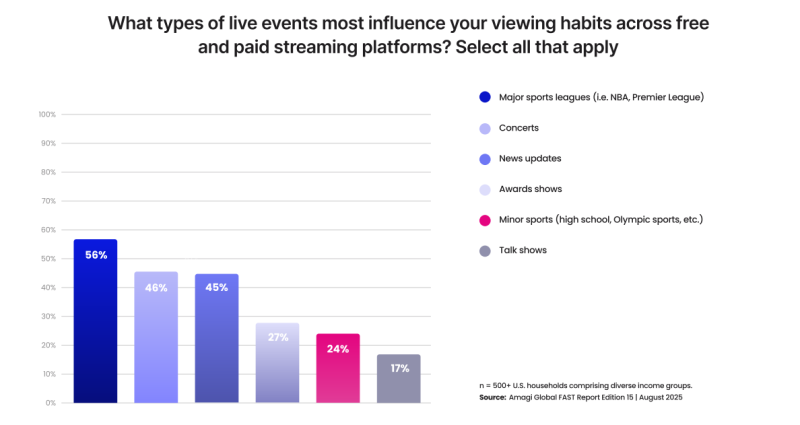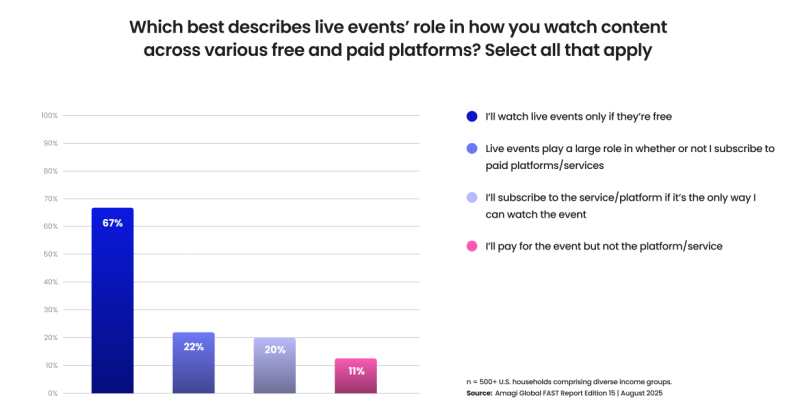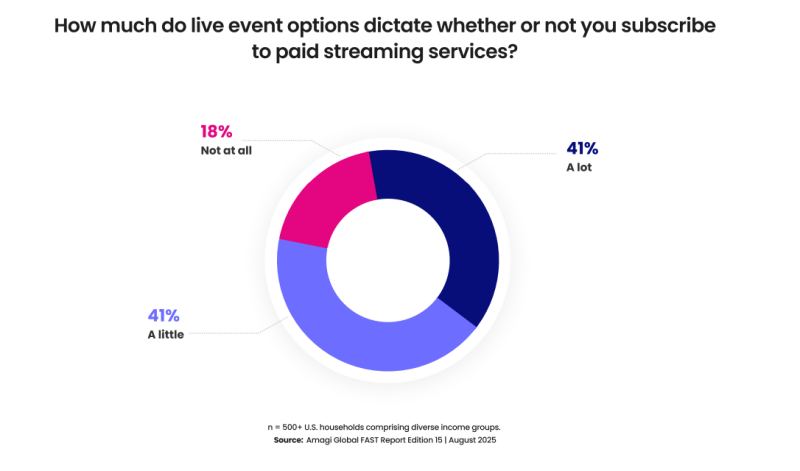The free ad-supported streaming TV (FAST) space has gotten more mature and is not quite the Wild West it was just a few years ago. Still, FASTs continue to grow key content types and genres, with recent separate reports from Gracenote and Amagi shedding some light that live, including sports and news, is in focus for both viewers and providers.
On Wednesday Gracenote released its Q3 Data Hub that gives a glimpse of content catalogs for leading SVODS – and starting this quarter, for FAST services.
Per Gracenote, across FAST there are now 197,000 total TV shows, movies and sports programs.
Gracenote's latest Data Hub also shows that the global FAST channel count now stands at nearly 1,850 – up 76% in the past two years and nearly 14% since Q1. Earlier Gracenote data found sports had grown the be the No. 2 FAST genre by channel count, a ranking it still holds. That said, sports FAST channels still distribute very little programming when compared against the aggregate across all FAST content.
As we talk about live, sports are seen as a key category that help attract users and advertising dollars, but Amagi’s August Global FAST Report and consumer survey of 500 U.S. households show it still dominates live FAST programming but is not the only type of live content viewers are regularly tuning into.
In terms of the type of content distributed on FASTs, Gracenote found the amount of sports content grew 13.95% in the first half of the year – although declined by 3.6% in Q3 versus Q2. Note, Gracenote’s Data Hub doesn’t break out live sports content from other sports programming like sports documentaries or series.
Still, as of Q1 Amagi found that, similar to cable, sports represents the most dominant genre in live programming in FAST – accounting for 84% (followed by talk shows at 14% and other at 2%), based on live events managed by Amagi from January through March.

Roku is among FASTs that have leaned into sports content, including through the dedicated Roku Sports channel that aggregates live and sports-related content like MLB Sunday Leadoff games and Formula E races, among other content offerings. There are also dedicated services and channels like Free Live Sports and the recently debuted women’s sports-focused FAST channel from Swerve TV.
And this month sports-focused FAST channel operator C15 Studio launched two new channels for clients. Those include MotoGP featuring live race weekends and library of curated content, as well as a Yahoo Sports Network linear streaming channel with original programing covering major leagues like NFL, NBA, MLB and more.
Asked by Amagi about benefits of offering live sports on the Free Live Sports service, Cathy Rasenberger, co-founder of Sports Studio, said they’ve helped attract new users who may come for a live event, but then stay to engage with additional content. Live sports events are also driving fan engagement and viewership for the FAST.
“60% of the 125+ sports channels on FreeLiveSports.tv regularly air live games and events, driving significant upticks in viewership,” Rasenberger told Amagi. “Live Sports also increases monetization, driving higher CPMs and fill rates from programmatic ad buys and attracting new sponsorship dollars and direct ad buys from brands seeking higher fan engagement in live sports.”
Live programming is more than sports
While still not the bulk of programming found on FAST, consumers in general report tuning into live events regularly, and it’s not just sports but also content like news updates and concerts.
Among respondents to Amagi’s Global FAST report, 35% reported watching live events daily and the same percentage said they watch weekly. Around a quarter said they rarely watch live events and 16% reported doing so monthly.
In terms of how they watch, 67% of Amagi survey takers said they tune into live events via paid or free streaming – significantly higher than second-place cable or pay TV at 39%, as well as outpacing traditional broadcast (32%) and social media (26%)
When asked what type of live events most influence viewing habits across paid and free streaming platforms, major league sports (like NBA, Premiere League, etc), perhaps unsurprisingly, were the most cited at 56%.
But interestingly, other types of live events also ranked high, including concerts (46%) and news updates (45%). And roughly a quarter of Amagi’s respondents cited awards shows and minor sports as most influential.

In terms of news ranking high for influencing consumer streaming habits, FASTs also appear to be leaning into this type of content.
Per Gracenote’s Q3 data hub, the amount of news content on FAST was up 37% in the past three months and it is now the third most-represented genre on FAST channels, behind drama and documentaries. The news genre accounts for 9.9% of the total programming distributed by FAST.
A push towards live events like concerts can also be seen in recent examples on platforms such as Samsung TV Plus, which starting August 10 has been live streaming the Jonas Brothers’ North American tour (next live stream is August 31 from Dallas, Texas).
The music tour marks the first major live event to launch on Samsung Television Network – the FAST’s recently launched flagship free streaming channel.
Meanwhile, some consumer responses in Amagi’s latest FAST report appeared to conflict or muddle just how influential the live event proposition is when it comes to subscribing to paid services.
In a question asking how live events impact how viewers watch content across free and paid platforms, a whopping 67% said they’d watch live events only if they’re free, while 22% said live events play a big role in whether or not the person subscribes to a paid platform. About one-fifth said they would subscribe to a service or platform if it’s the only way they could watch a live event.

But in the next question, when asked how much live event options dictate whether or not a person subscribes to a paid streaming service, a robust 41% said “a lot” and another 41% said “a little”, with less than one-fifth saying live event options don’t dictate their subscription to a paid service. So there appears to be some disconnect in how willing consumers are to pay for live content and how impactful they view the availability of live events on decisions to sign up and pay for a subscription service.

Article updated with additional data from Gracenote.